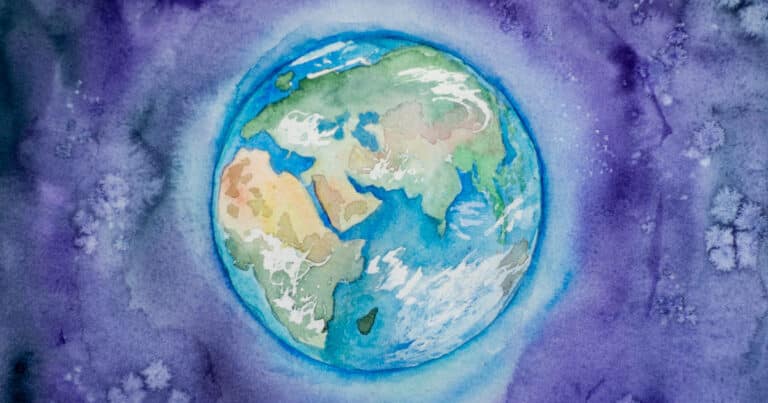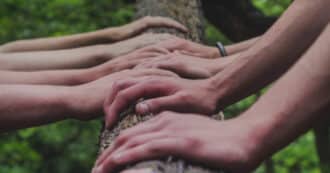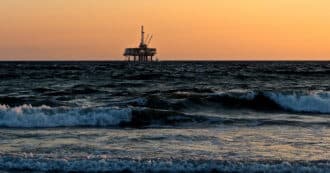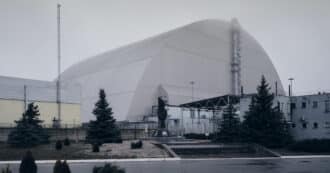By David Miron-Wapner

Passover and Earth Day coincide this year. The juxtaposition of these ancient and modern days can help augment our awareness of the pharaoh-like power humanity collectively wields so abusively in relation to our Mother – the Earth. We humans – in Hebrew B’nei Adam -are 100% earth elements – in Hebrew Adama – imbued with consciousness and perhaps a conscience.
This is the story of one Earth people, just a large clan or small tribe, all children of the same nation. They seek refuge from persistent drought impacting their own chosen land of promise, finding asylum in the midst of their most powerful and gracious neighbor. For some time all is harmonious, everyone prospers, the economy grows, especially with a new source of productive labor and entrepreneurship. By the time the drought is over, the clan has re-settled amidst its hosts. Then the exploitation begins. Power and greed, feeding off one another in a deathly spiral of “more, bigger and grander,” lead to the emergence of a completely unbalanced relationship of exploitation and oppression, from which the clan, still clinging to its original identity seeks liberation.
As a traditional people, engaged in herding and agriculture, the children of Israel certainly lived on a smaller scale than the far greater, civilized society of Pharaoh’s Egypt. Their basic identity revolved around the land and its seasons. Their ancestors had domesticated animals and wild grains. Theirs had been a land of milk and honey, also abundant in – olive oil. And then something occurred, at the time probably just cyclical weather and climate patterns, thoroughly disrupting their ability to sustain themselves.
The Children of Israel went to Egypt seeking economic asylum, as the result of a famine in their own land. Famine is the outcome of a long process of deterioration of sustainability. In our times similarly, we are increasingly bringing upon ourselves the plague of drought, as well as its polar opposite, floods washing away topsoil, creating many more refugees seeking relief from failed farms and an inability to adapt to harsher and harsher climatic conditions. How many are aware that the chaos and brutality Syria is experiencing stems from a 2006-2010 drought of Biblical proportions, not seen for over 900 years? Sixty percent of its arable land became unproductive, farms failed and its people sought refuge in the already overcrowded cities of a collapsing state.
Confronting Business as Usual on Earth Day 2016
The ecological crises of our times impacts us more today than most of us imagined at the inaugural Earth Day in 1970. It is much more than “just” climate change that is bringing us dramatically extreme weather events as harbingers of disaster emerging on humanity’s path to an uncertain future. Alongside this grave threat to modern, comfortable, progressive human civilization there is also wanton destruction of biodiversity, burning of the rainforests, toxic chemical waste, fresh water scarcity and urbanization.
In the face of all the devastation of so much of creation, we continue to pursue “business as usual” in a stubborn and obdurate fashion, anything to avoid moving beyond the holy grail of our modern industrial market system, consumption and endless growth, towards a more balanced human society based on prosperity, liberty and the pursuit of meaning and happiness.
We may be able to point to certain objective causal factors for our ecological quandary. Profligate waste of resources, toxic chemicals fouling our waters, CO2 pollution, over-population. All relate to a basic ignorance. A lack of understanding that humanity has accumulated the power to disrupt the Earth’s natural systems evolved as part of the process of creation with a purpose – to support life, all life in all its glorious, wondrous forms. So too, there may be objective fixes, mostly employing more innovative, effective and powerful technology the misuse of which got us into this mess.
Ultimately, none offer a true solution to what at the heart is not an objective problem. Rather it is a crises of the spirit, stemming from an imbalance in humanity’s relationship with the Earth – the Adama from which we all were formed. Unless and until we direct our attention to this more fundamental crises we will continue to destroy the planet out from under our feet.
The Exodus from Egypt led the Israelites to wander in the wilderness of the Sinai. The crucible of the desert reminded them of what it is to live simply, in harmony with their surroundings, relying on what they could glean.
Early Farmer Devil’s Bargain
At the end of their journey, Jews returned to Israel and resumed an agricultural economy, having been in the forefront of the agricultural revolution. Farmers in the region had made what has turned out to be a devil’s bargain with a limited number of the hardier strains of wild grains and certain cooperative animals to the detriment of diversity. Advances in agriculture were made by human ingenuity and insights, leading to innovations, progress and apparent abundance. Nothing was designed with an overall purpose or appreciation of the tradeoffs made along the way.
Not unlike the Agricultural Revolution that preceded it by 10, 000 years, the Industrial Revolution was not designed rationally. It unfolded haphazardly, leaping from one innovation, the cotton gin, to the steam engine, light bulb, telegraph, telephone, TV and the silicon chip. In, the industrial and now post-industrial world, machines of metal and plastic, and efficient cheap, chemical fuels have taken the place of human and animal muscle, but the exploitation of masses of people that began with pharaoh’s work gangs continues in the form of the assembly line, the white collar office workers each in a wired cubicle. The worker is seduced by an advertising-fueled consumer market where each newer gadget is better, allowing us to discard the old and still functional. Like in Egypt in the disparity of wealth and power left more and more people suffering.
Passover is a holiday of the spring, a time of renewal and rebirth. Here, Jews celebrate the birth and renewal of a people forged during their wanderings in the wilderness. In Sinai, they struggled to redress their relationship with Nature, which had been severed in Egypt. A true camaraderie with nature is possible only when a living presence of nature exists. As urbanization takes hold, dominating and subduing every vestige of that vital presence in its way, wild things have no autonomy, no space to survive.
The Real Symbolism of the Seder Plate
At the Passover, Jews celebrate and bless various foods, as symbolizing elements of the story. Today Jews need to understand not only the symbolism of this food, but also its sources. Jews are called to become aware of the impact of industrialized agri-business on the soil and water, and the extra costs in energy to bring this great abundance to the Seder tables. This heightened awareness must extend from the systemic all the way to the smallest personal actions, sensing the myriad ways we interact with and impact our environment.
The urbanization of Egypt around the narrow space of the Nile has become the norm in our world. We all feel the constriction, the choking congestion. Too easily we have bought into the illusion of endless growth and development. The children of Israel needed to escape the bondage of the urbanization they were building brick by brick, to celebrate wilderness wandering and get back to their land to tend their own gardens.
When Pharaoh, the embodiment of human power, refused Moses’ entreaties, over and over, in spite of mounting and overwhelming evidence of God’s supernatural power, God hardened Pharaoh’s heart. While a popular English translation, it might be better to say stiffened, encased, or covered. Individually and collectively humanity has been stiff-necked and stubborn in its refusal to heed clear scientific evidence that continuing our current abundant Western life-style in pursuit of endless growth is perilous. We have been warned, repeatedly, each warning more disturbing and dire than the last; ice sheets melting, acidification of oceans, massive bleaching of coral reefs, all leave us fearful and frozen.
At Passover, Jews are directed to tell the Passover story to their children and grandchildren. The admonition to pass the story on from generation to generation wisely teaches a long-term inter-generational perspective
As well, Jews are called upon to reject hard-heartedness, stubbornness and obstinacy, to cease being stiff-necked, individually and collectively taking full responsibility for their actions and omissions. In a revealing passage in Deuteronomy 10, verse 15 we see the same Hebrew word, signifying the heart being covered, trapped and impenetrable, literally “uncircumcised.” Our hearts are encased, enslaved by the illusion of separateness, from one another, from other species, from the Earth. How do we remove the covering on our hearts and help others do so as well? Once opened, freed of its outer shell, how do we soften our hearts, especially men, and prevent going back to old patterns of abusing our power? Without a healthy I-Thou relationship with our Earth and its purposeful life-sustaining systems, any path to a true relationship with the divine and real transcendence is blocked. May we be blessed this Passover and Earth Day with the capacity to open ourselves to new ways, soften, repent and become more receptive, turning towards a new balance.
David Miron-Wapner is board chair of the Interfaith Center for Sustainable Development.





